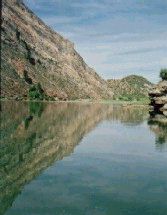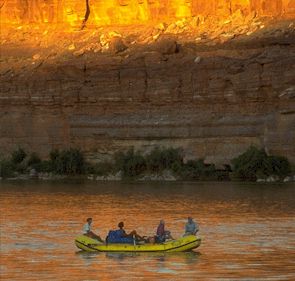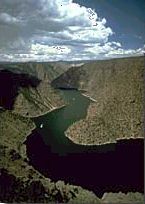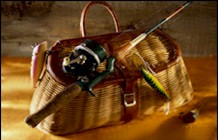The Green river, from it's majestic, yet humble beginnings
in the Wind River Mountains in Wyoming to it's confluence with the mighty Colorado River,
is still a beautiful, inviting slice of nature. It's largely
unsettled territory and wealth of natural resources beckon to
those who know of it's timeless qualities.
The
Green River below Fontenelle Dam.
 |
Mountain men of the 1800's and characters of the old west
were drawn to the Green River country and legends from that
era still abound. Jim Bridger called this area home base for a
time and Butch Cassidy and the Wild Bunch often retreated here
to escape pressure from the law.
Today, it is an anglers paradise, drawing fishermen from all
over the world. Green River country also attracts many
hunters, whitewater enthusiasts, backpackers, sightseers,
mountain bikers, x-country skiers and all-round nature lovers.
Even the natural history of the Green River corridor is
intriguing. Geological formations of all types abound and
nearby is one of the largest deposits of fossils and dinosaur
bones found anywhere.
If variety is the spice of the outdoorsman's life, then this
river system must be one of the great Mecca's of the natural
world. It's world class fisheries boast six species of trout,
something that can be said of few river systems. The cutthroat
trout was native but the brown trout, rainbow trout, brook
trout, lake trout and even the elusive golden have been
successfully introduced and are prospering. Grayling inhabit
some of the headwater lakes. Largemouth and smallmouth bass
are available in Flaming Gorge Reservoir, as are kokanee and
catfish. Even a few northern pike exist down around the
Colorado, Utah border.
Rafters
enjoy the beautiful colors in
the canyon that evenings produce during summer.
 |
Flaming Gorge Dam - To The Colorado River
The Green River from Flaming Gorge Dam in Utah to the
Colorado State line is the most popular section of river for
anglers. It sometimes sees 150,000+ anglers days per year and
holds up remarkably well despite the numbers of fishermen.
Eighty percent of the fishing pressure is located on the seven
miles from the dam to Little Hole. The canyon Little
Hole (formerly Little Brown's Hole) is known as Red Canyon and
was named by Major John Wesley Powell's expedition in 1869.
The river currently is one of the best fisheries in the
continent and is definitely a world class fishery in every
sense of the term. It has a fascinating angling history that
aptly illustrates the value of special regulations and
informed management.
Flaming
Gorge Reservoir.
 |
Flaming Gorge Dam, near the Wyoming State line, was
authorized in 1956, begun in 1959 and finished in late 1962.
Previously, the river was warm, muddy and supported few if any
trout. Squawfish, chubs and suckers, including some varieties
that are unique to this drainage, were the main river
inhabitants. Powell's expedition called a species of fish in
the river "a queer mongrel of mackerel, sucker and
whitefish", and another one "an afflicted cross of
whitefish and lake trout". Descriptive terms for fish
that are now endangered, protected fish. The protected species
include the Colorado squawfish, razorback sucker, humpback
chub, bonytail chub and roundtail chub. The canyon was
regularly ravaged by spring floods that carried huge volumes
of silt, sand and rocks, creating rapids and sandy beaches.
When the dam was completed and the water behind the dam
began to rise the once muddy waters cleared of silt and became
cooler. The state fish and game officials took quick advantage
and stocked brown and rainbow trout. The fishing was very good
for a few years but as the waters rose in the reservoir, the
water coming from the bottom of the dam began to cool until it
was in the 30's and 40's (Fahrenheit), year-round. The growth
rate of the trout slowed considerably and fishing suffered.
The problem was acknowledged and in 1978 modifications were
made on the dam to draw water from various depths of the
reservoir. Being able to control the water temperature helped
the fish considerably and it soon became a popular fishing
destination.
With ideal conditions rainbows, cutthroats and browns grew
at a staggering one to two inches a month, during prime
seasons.
Before long fish averaged 13 to 24 inches with a
number of even bigger fish. One in ten fish was over 20 inches
and a few monsters in the 30 to 36 inch range were available.
A fishery like this can not be kept secret for long and by
1987 a number of guide services were operating on the river
and articles began appearing in the major fishing
publications. Fish surveys during this period reported up to
an incredible 22,000 fish per mile, in the first few miles
below the dam.
Today there are fewer fish because of reduced stocking but
their growth rates are back up and most of the fish are nice,
fat and healthy. With fish numbers from 6,000 to 15,000 fpm
now, the Green River is still a world class fishery, but the
fish do require more finesse to catch. Some anglers quit
fishing the river the past few years and others became
disillusioned because they were catching fewer fish than
before. The fish have been educated.
The 30 miles from Flaming Gorge Dam to Colorado State line
is divided roughly into three sections. Section A (as it's
referred to by the Forest Service) is from the dam to Little
Hole, Section B is from Little Hole to Taylor's Flat Bridge
(in the upper end of Brown's Park) and section C is from
Taylor's Flat Bridge to the Colorado State line, near the
bottom of Swallow Canyon. Each section has access points by
road and each makes a nice day float. As mentioned earlier,
Section A sees 80% of the fishing pressure because of better
trout numbers and easier access. It is also the most scenic
section of river.
A Remarkable Fishery
The Green River has crystal clear water for most of the
year. Flaming Gorge Reservoir is nearly 100 miles long and
cleans the sediment that comes down feeder streams and the
Upper Green River drainage. It collects dissolved nutrients in
the lake and gushes out the bottom of the dam as a rich,
man-made spring creek. Having such a clean, fertile water is
bound to increase the overall biomass of a river and the Green
is no exception. One study showed over 1000 scuds per square
yard of stream bottom! There are nearly that many mayflies and
several times that many midges in addition to caddis,
craneflies, aquatic redworms and a few stoneflies. As with
many tailwater fisheries, there are only a few species of each
insect group but what it lacks in diversity it more than makes
up for in overall numbers or biomass. There needs to be lots
of food to support the fish populations mentioned earlier.
Most of the seasonal changes in trout feeding behavior
parellels insect movements, hatches and other food sources.
Because of the clear water the trout are very visible. There
are few rivers where trout are easier to see than on the
Green. On shallow riffles, in big eddy lines, on the bottom of
deep, slow runs and even on the edges of rapids, trout can be
seen cruising and feeding. Having such a clear view of the
trout we fish for has made the transformation of the fishery
very interesting and visible.
Even with all the changes in the fishery in a short time
there are some fishing techniques and types of fly patterns
that are standards, but many of the fly patterns change as
fish get used to them. Flies like the Chernobal Ant, Peacock
Crippler, Tar Baby, Disco Scud and hundreds of other
variations have been developed to get the attention of Green
River trout. Each guide has his own favorites that he keeps
undercover - except for his clients.
Seasons on the Green
Winter is a fun and uncrowded time to fish the Green River
if your clothing system can keep you warm. The surrounding
mountains often get lots of snow but roads are kept open and
the river itself seldom sees more than one foot of snow.
Daytime temperatures fluctuate anywhere from -20 deg. to + 50,
depending on the day. Weather systems on the Green River
usually come from the Salt Lake City direction and take about
a half day to get there. Watch the weather reports and figure
that the Green will be about a half day behind and about 15
degrees colder.
Spring brings ubiquitous baetis hatches and the trout group
up for spawning as well. It is the best time of year for large
trout because they have been through winter with little
fishing pressure. They move into shallows to begin spawning or
to feed and you can spot-fish these large cruisers. Fish egg
patterns, scuds, small nymphs and San Juan Worms to nymphing
trout and olive duns, midges or emerges to risers. If the fish
reject dry flies, use emerger or nymph versions.
Summer brings crowds of recreational floaters but fishing
stays good with pale morning duns, midges and caddis supplying
the main hatches. In mid-summer evening, try large attractor
dry flies in fast water and watch out. Caddis can be effective
near dark. Terrestrial insects like beetles, ants,
grasshoppers and cicadas are plentiful and streamers sometimes
work well. Most nymphing is done with very small nymphs.
Late summer and fall sees some of the most challenging
fishing of the year. The fish have become re-educated and
light tippets, accurate, drag-free presentations and small
flies are a must for consistent hookups. Small baetis are
hatching, with a large one going only a size 18. If the
selectivity of slow water fish are frustrating you, move to
the riffles and use tiny nymphs. If you want to sight fish and
test your skills against some of the most selective trout
found anywhere, this is the time of the year that is most
challenging. Weather can be quite nice or not so nice. Prepare
for anything.
Floating the Green
Floating Section A from the dam to Little Hole is a great
way to see Red Canyon and get some great fishing along the
way. From April through October shuttles can be arranged
through Flaming Gorge Flying Service (Dutch John Airport) or
Flaming Gorge Lodge. Have them shuttle your car for you or
meet the morning shuttle bus at Little Hole and ride back to
the dam (launch your boat first). If the river is crowded try
putting in in the afternoon and doing a late float.
You're likely to see people floating down the river in all
kinds of watercraft from dories and rafts to canoes and float
tubes. The first two are fairly safe. The last two are
dangerous. The rapids of the Green River are not extremely
dangerous but serious enough that unskilled or unaware
floaters can get into trouble fast. The worst culprits are the
big rocks in fast water just under or above water level. They
often have enough suction or turbulence to flip small craft.
Flaming Gorge Bass
In my opinion the most fun a fly rodder can have on Flaming
Gorge Reservoir is to go after the smallmouth bass. Their
populations have exploded since their introduction a few years
ago. There are incredible numbers of eight - to 15 inch
smallmouths. Some beauties to four plus pounds are around.
They are widely distributed through the lake now and go nuts
on anything that looks vaguely like crayfish, their favorite
food. It is also the home for many trophy lake trout, brown
trout, and rainbow trout.
The Green River [Wyoming/Utah, USA] is one of those places
that can get into your soul. It's a relationship that can
become a part of who you are. Since humanity left life as
hunter-gathers and turned to communities or what some call
"civilization," we have also seen the need to turn
back to seek refuge in nature. Many seem compelled to seek out
the sensations of our primordial heritage, which seems to
awaken senses that are dormant or dulled by our civilized
existence. ~ Larry Tullis
|






